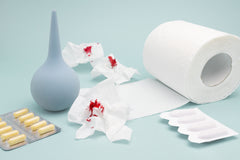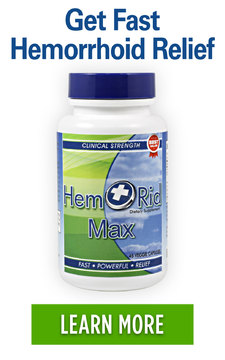How Do I Stop The Pain of Piles - Secrets, Tips & Tricks You Must Hear About
Posted on 10 September 2018 by Maryanne Johnson
Share this post
How do I stop the pain of piles? How can I ease the pain of piles? Anal itching, rectal burning, and a hot, throbbing sensation—all of these symptoms are familiar to those who struggle with piles, but perhaps the most difficult to manage is the crippling pain that can come with piles.
Veteran hemorrhoid patients and people who are new to developing hemorrhoids continually ask themselves and their GPs, “How do I manage the pain?”
When the pain of piles obstructs daily life on a more than the occasional basis, it is time to revisit your approach in treating them.
With this guide, an overview is provided detailing widely utilized remedies that effectively treat the pain of piles and what you can do as a patient of hemorrhoids to prevent an outburst.
How Do I Stop the Pain of Piles?
There are a plethora of methods that can be employed in the comfort of your own home to treat piles. If piles are a persistent problem for you and you, find that symptoms of pain, irritation, burning, and aching return with the piles, your first step should be discussing a thorough treatment plan with your GP.
Hemorrhoid Creams for Piles Pain
To immediately relieve the pain of piles, many sufferers turn to use topical treatments like creams, ointments, and wipes infused with anti-inflammatory medications and ingredients.
There are numerous topical ointments available for purchase at your local drugstore, but as with any drug, it is best to check with your GP before using one on the sensitive rectal area.
Hydrocortisone for Piles Pain
Ingredients like hydrocortisone can dramatically lessen the pain felt by piles when applied in the form of a topical treatment.
Formulas are created to target issues of inflammation, discomfort, sensitive itching, and burning by deadening the sensation of the pain-sensing nerves via a coat of the applied cream.
Sitz Bath for Piles Pain
In the piles community, patients utilize sitz baths, a bath where the water submerges the rectal area completely, focusing on cleansing and relieving the symptoms of external and internal piles in the anorectal region.
Warm sitz baths can work to reduce swelling as well as clean the anus to subside anal itching, a symptom that can range from mild to extreme for individuals with either or both types of piles.
For additional relaxation, many people add Epsom salts into their sitz baths, essential oils, and other bath goods.
While the effects of these bath additives do not enhance treatment of the symptoms, some can help relax the rectal muscles, which for some people with piles, reduce the strain on the anorectal veins, even if temporarily.
Mental wellbeing is as equally essential as physical health, and by providing a stress-relieving, warm bath, you may alleviate frustrating pain for piles for a while.
OTC Medicines for Piles Pain
Medicines are available for over the counter use with pain-relieving ingredients to target the painful inflammation, swelling, and hindering symptoms of piles.
Many pain-relievers aids in muscle strain, a benefit for those with piles due to the restricted blood flow of the rectal muscles and venous channels.
Read the instructions listed on the products' labels before taking any of this medication, and if you are concerned if over the counter pain-relievers will interfere with other prescribed medicines you are taking, then you should discuss this treatment method with your GP first.
How Do I Ease the Pain of Piles?
Having external piles is a nuisance. Fleshy, rubbery lumps, sore to the touch, populating the anal area and ranging in size depending on severity, these hemorrhoids make sitting, standing, and moving about uncomfortable and painful.
Going to the toilet and passing stools is more difficult and worrisome with external piles and can worsen the pain.
The persistent rectal condition of piles has been around to plague humankind for centuries, but because of this, sufferers have discovered creative methods to ease the pain of pile.
Do Cushions Ease Piles Pain?
One, for example, is a soft hemorrhoidal cushion that can be sat on to protect the rectal areas from hard surfaces, like benches, booths in restaurants, and an uncomfortable chair.
Cushions can be inflatable and portable for added ease of transport and discreet carrying. Although sitting on hard surfaces don't necessarily worsen the piles or prolong their presence, you should not have to suffer through the pain of piles until they decide to go away.
Others have sought the help of pelvic floor exercises, a physical therapy approach designed to strengthen the rectal muscles. The muscles in the pelvic floor are essential in delivering the rich supply of blood to the rectum, anus, and genitals.
By practicing certain exercises, you can engage the supply of blood and encourage the venous channels to perform with increased functionality.
The best way to ease the pain of piles is through prevention, but remember, methods of prevention like the modification of diet and lifestyle to reduce the risk of developing piles doesn’t happen overnight and may not eliminate piles pain right away.
However, preventative steps are necessary to stop anorectal veins, blood vessels, and tissues from becoming inflamed, which in turn will substantially limit symptomatic outbreaks.
Preventing the Pain of Piles
For many people, a fibre supplement is often assigned per the advice of their physicians. One of the most common reasons behind the development of piles is straining.
Straining on the toilet, or physically straining while lifting heavy objects, hinders the passage of blood to the rectal area.
Because piles are inflamed blood vessels due to the complication in the blood flow, either by a sudden restriction, or weakened connective tissues due to the aging body, it is more crucial for those prone to developing piles to work to prevent them.
Keeping the colon regular and healthy and maintaining toilet habits that support blood flow instead of constricting it are key steps to take in the prevention of piles and the pain that comes along with this anorectal condition.
Does Fibre Help With Hemorrhoids Pain?
Fibre softens the stools by contributing to the faecal matter’s moisture content. Fibre also bulks stools, and while bulking may seem like it would harden the stools, in actuality, the fibre makes the stools more comfortable to pass.
Fibre can also be consumed in foods like whole grain bread, lentils, beans, nuts, and of course, fruits and vegetables.
Soluble fibre is essential in managing and preventing hemorrhoidal pain. Taking fibre supplements and including more fibre in your diet may not control the pain of piles right away, but within a few days, fibre can aid the colon in the regulation of proper bowel movements.
Your GP will likely instruct you to strive to maintain a healthy lifestyle, which means managing your weight to prevent obesity, avoiding sitting and standing for extended periods of time, drinking plenty of water throughout the day, and being sure you are getting in an appropriate amount of exercise during your week.
Staying hydrated can help with constipation and other chronic gastrointestinal issues, and exercise promotes circulation of the blood supply throughout the body, essential for healthy rectal veins.
Meanwhile, maintaining a healthy weight for your age, height, and gender will place less pressure on anorectal veins and tissues, ensuring that inflammation is kept at bay.
If these tasks are new to you, it can be a challenge to modify your lifestyle, but by making even small changes, you can prevent and lessen the pain and occurrences of piles.
Anything and everything you can do to decrease the amount of pressure and strain on the rectal veins and blood vessels will contribute to lessening the chance of piles developing internally or externally.
This may include removing yourself from situations where heavy lifting is required due to the straining it places on rectal veins, or to decrease the amount of time you spend sitting on the toilet to reduce pressure on the anal cushions.
Conclusion
Reducing the pain of piles can be approached in two waves: treatment and prevention. By treating the symptoms of piles, you can begin to focus on what may be the cause behind the development of your piles and work to resolve it.
There could be multiple reasons behind piles, so it is important to discuss every symptom with your GP to establish a treatment and preventative plan right for you.





0 comments